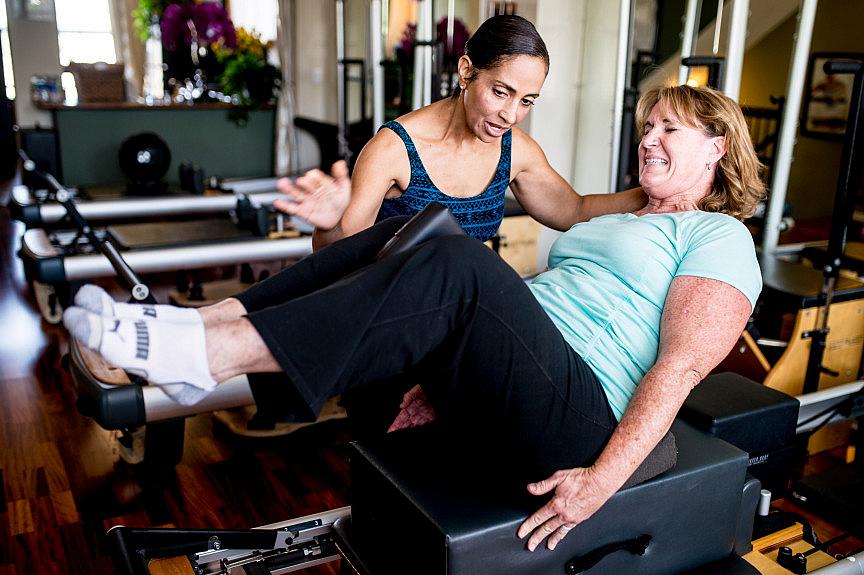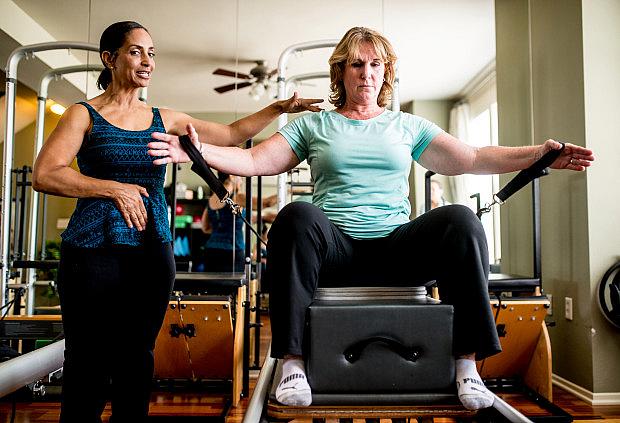Surgeries, therapy and pain: San Bernardino terror attack survivor details horrific journey to recovery
This story is part of a four-part series on Dec. 2, 2015, terrorist attack survivors’ recovery and California’s workers’ compensation system. The project was undertaken for the USC Center for Health Journalism’s California Fellowship.

Julie Swann-Paez, a survivor of the Dec. 2 San Bernardino shooting, works with Pilates instructor Valerie Chargois to strengthen muscles during her recovery at Pilates 909 in Rancho Cucamonga on Saturday, July 15, 2017. Swann-Paez was shot twice in the pelvis during the terror attack. (Photo by Watchara Phomicinda, The Press-Enterprise/SCNG)
She remembers the voices as she lay dying outside the Inland Regional Center on Dec. 2, 2015.
The voices kept asking her name and age, over and over, as she lay in triage with her eyes closed.
Julie Swann-Paez had been shot twice in the pelvis in a terrorist attack by her Muslim co-worker and his wife. She was losing blood and consciousness. Her blood pressure was plummeting.
“If I can stay conscious, if I can keep answering their questions, I’m going to survive. I’ll make it if I can get to the hospital,” she told herself.
The 50-year-old San Bernardino County Environmental Health Services inspector barely survived the ambulance ride to Loma Linda University Medical Center and emergency surgery to find and stop the bleeding.
She’d lost almost all her blood, needing more than 10 pints. Surgeons cleaned and closed the bullet wounds, repaired the damage, stabilized her shattered pelvis by screwing protruding metal rods into her hip bones and gave her a colostomy.
Mass shooting aftermath
Julie Swann-Paez, a survivor of the Dec. 2 San Bernardino shooting, works with Pilates instructor Valerie Chargois to strengthen muscles during her recovery at Pilates 909 in Rancho Cucamonga on Saturday, July 15, 2017. Swann-Paez was shot twice in the pelvis during the terror attack. (Photo by Watchara Phomicinda, The Press-Enterprise/SCNG
A year later, she met tcohe paramedic and EMT behind those voices. She wanted to thank them. It was the first time she saw their faces. They told her working amid the carnage had been somewhat traumatic. They wanted to see if she was OK.
Now, what stands out most to her about Dec. 2 was her ability at self-preservation. After the first bullet hit, she lay curled up on the conference room floor playing dead while the attackers sprayed bullets across the room.
As her co-workers screamed, Julie wished those near her would stop so they wouldn’t draw the shooters back to that corner and focused on staying calm, even when she was shot a second time and blood was spilling out.
“I was imagining the sound of the ocean. Thinking about the beach — the waves hitting, the sound of the wind,” she said.
Two years later, she gets counseling for post-traumatic stress three days a week and her mind still replays parts of the attack — Syed Rizwan Farook entering, coworkers dying.
Difficulty getting treatment
Yet she also replays memories of what she, other survivors and trauma experts describe as secondary trauma — their problems getting medical treatment, medicine or equipment through the county’s self-administered workers’ compensation program when doctor’s treatment requests are denied, delayed or reduced.
County officials didn’t step forward to help in any way and seemed to turn adversarial toward survivors like Julie who needed attorneys to help navigate workers’ compensation to get the benefits they’re legally entitled to after being injured at a county training event/holiday party, she said.
State workers’ compensation division officials told the county a year ago they don’t have to send every treatment request to outside utilization review, but the county still is, she said, describing the county’s actions as “SB Wrong” — a play on the phrase “SB Strong” that was coined after the attack but later felt like a slap in the face to survivors.
While she and her coworkers felt betrayed by Farook, Julie said he never made them promises, but she had higher expectations of the county.
“The real betrayal is from our employer. They have betrayed those who survived that room more than anyone,” said Julie.
For her, after-surgery pain medication has been denied. Counseling, physical therapy and medication for PTSD, anxiety and depression have been reduced. She had to pay for her first blood pressure medicine needed for the stress of facing treatment denials and delays.
A physical therapist visited for two months while she was housebound to do limited work. Julie had three more surgeries to remove the stabilizing rods, reverse the colostomy and remove adhesions and scar tissue in her abdomen.
Road to recovery
After the rods were removed and she began walking again with a walker, she was approved for eight weeks of physical therapy in the first 11 months to help strengthen weak muscles and work on her gait. Another six weeks were approved in November 2016, so Julie pushed herself to do physical therapy exercises at her San Bernardino home and walk in the mornings, trying to eliminate a painful limp.
Walking 5 to 10 miles daily before the attack, Julie rarely walks and does no more than 1.5 to 2 miles. This year, her orthopedic surgeon pushed her to do pilates — less costly than physical therapy and effective for strengthening her pelvis and other muscles to make up for muscles now gone from the left side. Sixteen sessions a month were approved for six months, then more pilates was denied in the summer.
Today, Julie has pain sitting for too long, getting in and out of the car, and walking long distances or up and down stairs and hills. She can feel her body weakening.
Hundreds of pieces of shrapnel remain embedded in her, from her pelvis and abdomen to a thigh. A bone spur from her pelvis sticking into her bladder makes her have to urinate frequently. It will remain in her body after an attempt to remove it ended when a surgeon accidentally cut her bladder.
She tries to think positively, but she’s embarrassed about her medical conditions. She’s worried others won’t understand.
“The type of injuries I have — you can’t see them from the outside,” she said. “I’ll never be the same. But I want to be functionally better.”
She’ll need abdomen reconstruction surgery in a few months. But first, she’ll have recently approved surgery Dec. 5 to remove a hernia that grew at an incision site.
Julie’s temporary disability payments have just run out. Under current law, injured California workers’ wage loss compensation of $290 a week ends after 104 weeks. Assemblywoman Eloise Reyes, D-Grand Terrace, tried to increase the time by introducing AB44 last year to give Dec. 2 survivors up to four and half years of payments during recovery if needed.
But the bill was gutted by the Assembly Insurance Committee.
Unknown future
Julie was working her dream job when the attack happened. However, she can’t return to work yet because of pain, upcoming surgeries and recovery periods. Even if she could, the county would only have to accommodate her work restrictions for a year before legally being allowed to let her go.
But after the county’s handling of survivors’ workers’ comp treatment requests, Julie said she’s too disillusioned to return to working for San Bernardino County. That makes her sad.
She’s applied for medical disability retirement and is considering leaving the area with her husband and family to find a fresh start. She’d like to work again but doesn’t know what she could do — or if she’ll be employable with her injuries.
Her future medical issues are unknown, which stands in the way of making a permanent disability settlement with the county, because that must cover future needs.
“How would anyone else know what else is going to come up?” she said.
Two years after the attack, there’s still no permanent memorial to the 14 people who died at the Inland Regional Center or the 57 people who survived the attack.
The only memorial, then, is the scars that remain on the bodies and psyches of those who lived.
[This story was originally published by The Sun.]

